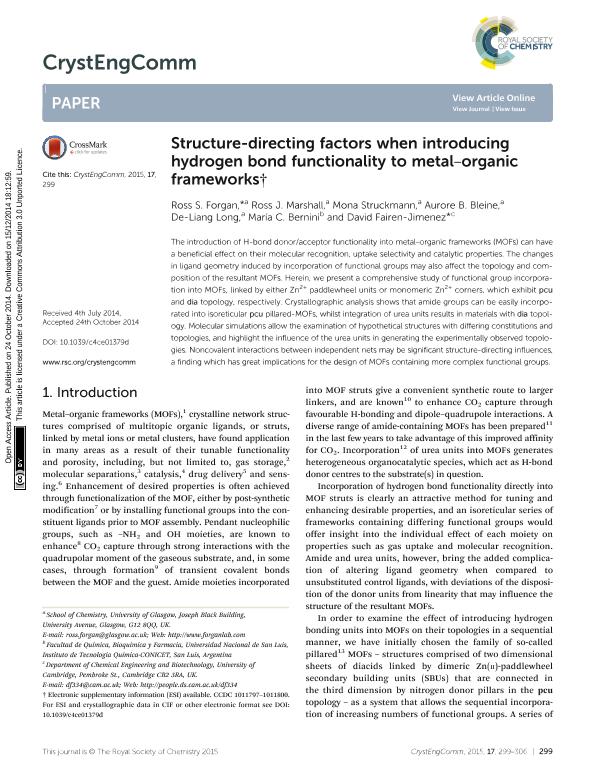Artículo
Structure-directing factors when introducing hydrogen bond functionality to metal?organic frameworks
Forgan, Ross S.; Marshall, Ross J.; Struckmann, Mona; Bleine, Aurore B.; Long, De Liang; Bernini, Maria Celeste ; Fairen Jimenez, D.
; Fairen Jimenez, D.
 ; Fairen Jimenez, D.
; Fairen Jimenez, D.
Fecha de publicación:
10/2014
Editorial:
Royal Society of Chemistry
Revista:
Crystengcomm
ISSN:
1466-8033
Idioma:
Inglés
Tipo de recurso:
Artículo publicado
Clasificación temática:
Resumen
The introduction of H-bond donor/acceptor functionality into metal-organic frameworks (MOFs) can have a beneficial effect on their molecular recognition, uptake selectivity and catalytic properties. The changes in ligand geometry induced by incorporation of functional groups may also affect the topology and composition of the resultant MOFs. Herein, we present a comprehensive study of functional group incorporation into MOFs, linked by either Zn2+ paddlewheel units or monomeric Zn2+ corners, which exhibit pcu and dia topology, respectively. Crystallographic analysis shows that amide groups can be easily incorporated into isoreticular pcu pillared-MOFs, whilst integration of urea units results in materials with dia topology. Molecular simulations allow the examination of hypothetical structures with differing constitutions and topologies, and highlight the influence of the urea units in generating the experimentally observed topologies. Noncovalent interactions between independent nets may be significant structure-directing influences, a finding which has great implications for the design of MOFs containing more complex functional groups
Palabras clave:
Mofs
,
Hydrogen Bonds
,
Topology
,
Molecular Simulations
Archivos asociados
Licencia
Identificadores
Colecciones
Articulos(INTEQUI)
Articulos de INST. DE INVEST. EN TECNOLOGIA QUIMICA
Articulos de INST. DE INVEST. EN TECNOLOGIA QUIMICA
Citación
Forgan, Ross S.; Marshall, Ross J.; Struckmann, Mona; Bleine, Aurore B.; Long, De Liang; et al.; Structure-directing factors when introducing hydrogen bond functionality to metal?organic frameworks; Royal Society of Chemistry; Crystengcomm; 2015; 17; 10-2014; 299-306
Compartir
Altmétricas



